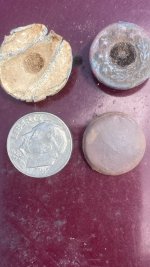nagant
Hero Member
- Apr 21, 2017
- 765
- 932
- Detector(s) used
- Tesoro Golden micromax, compadre. ML EQ 800
- Primary Interest:
- All Treasure Hunting
Running smooth so far but will check it out, thanks. Yeah i caught some fibers under my nail, before i deburred the holes. High speed but not to much pressure. Could you tell me what kind of epoxy and how do you thin it? thanks.





